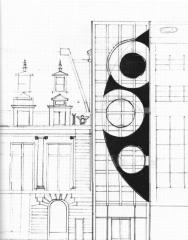 Proposal for MoMA
Proposal for MoMA
Just before Gordon Matta-Clark died in 1978 the Museum of Modern Art approved a proposal by him to cut into the façade of the original MoMA building before the first renovation and expansion of the building.
The piece was never executed. Gordon’s proposal was a bit of one-upsmanship on a certain level. Christo had proposed in the 1960’s to wrap the façade of MoMA but it remained a proposal. Cutting into the façade of MoMA was a lot more destructive than a gentle wrapping in canvas tarps.
The latest work to assault the edifice is the Doug Aitken projection work. Although I don’t know Aitken personally I was a friend of Matta-Clark’s. I find some very interesting parallel’s in their working methods and concerns. There are also quite a lot of differences. Matta-Clark’s work engages in a discourse with architecture. His work is also informed to a degree by the Situationistes notion of “détournement.” To cut into the MoMA façade is to critique the whole project of Le Corbusier’s “International Style” of architecture. Aitken on the other hand is dealing with a post-media environment where the architectural façade is a skin on which to project images. The dissolution of the minimalist architecture is accomplished by turning it into a screen. The images are part of a semiotic structure that is our 21st century world.
The issues of film and architecture were approached by Matta-Clark in many different ways. One such way was his “Underground Dailies,” piece. In this series Matta-Clark found ways to access spaces in New York that were not public with the purpose of shooting film such as the catwalks and utility tunnels behind/ in between the walls of Grand Central station or an abandoned subway tunnel, or the abandoned water supply tunnel by Grants’ Tomb or the new water supply tunnel that is 600 feet below ground.
I find a striking parallel in the way in which Aitken’s created his Sleepwalkers piece. Aitken’s shot film in areas with similar meaning in relation to the whole urban fabric of New York City. He shot in an abandoned subway tunnel, the unused helicopter pad of the Met Life building and behind the newsreader in Times Square. What I like about Aitken’s work is his sense of the city as a whole having a body and acting somewhat like an entity with a skin and a nervous system. Matta-Clark had a similar take on the city. In an early film montage work Matta-Clark spliced four films together vertically. He then projected them onto a wall constructed like a vertical ziggurat for an exhibition at the Holly Solomon Gallery. Technically the piece resembled earlier films done by the Dadaists but the addition of the architectural element put the work into the realm of sculpture installation art. In any case the multiple screens and disjunction caused by projecting Aitken’s work on various MoMA surfaces can be read as part of the same discourse on film and architecture.
Wolfgang Staehle and Gordon Matta-Clark
The dialog with architecture and projections was also approached by Wolgang Staehle in his projection piece done for the Spring (2006) Art Fairs on the Pier in New York city. In this case Staehle brought the outside in by setting a webcam view of the New Jersey shoreline across the Hudson River from the piers. This reminded me of the intervention on an abandoned pier in 1975 by Gordon Matta-Clark called Day's End in which Matta-Clark cut a giant hole in the front corrugated facade of Gansvoort pier, essentially bringing the outside in.